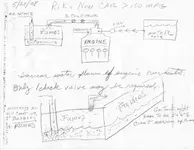OK Gollum, the lights beginning to come on!
...so I CAN do HHO HOD which doesn't require a bomb under the hood, other than the HHO generator and it's tubing...
...but it's gonna make my engine run 'cooler & smoother'

How will it run cooler

(Physics not a strong point here!)
I figgered more power so 02 sensor gonna tell computer to dump more fuel to compensate

I'm getting mixed up now...
But I can see I need to regulate both production, and flow of HHO, and meter it into the motor.
How do you determine how to fool the O2 sensor?
I ain't smarter than a computer!
Use a pyrometer in the exhaust?
That was expensive back when I drove trucks!
My Volvo had a boost guage, but no exhaust temp...
...and if is gonna run cooler with the HHO addition, how to figger which way to skew the O2 sensor.
Sheesh! CARB is gonna put me in jail for messing w/ smog system on a vehicle! Feds, too!
But that's ok.... guaranteed calorie intake, spanish lessons, and a dry bunk.
My truck's got 110k miles on it now, and running very well, so the engine is not real tight and gonna freeze up too fast if I give it a bad mix skewing the computer, but I know from personal experience you can hole a piston or burn valves in a big hurry.
What is best economical way to determine what's really going on within the motor as you are going down the road with a varying throttle setting?
I remember having a vacuum gage on a couple different old cars way back when...
LoL Ran outta gas a couple times, here and there... too busy to stop at the pump, just HAD to get to the project!... and I ended up dumping a gallon of lacquer thinner in the tank to get us rolling...
It don't run very good on THAT stuff!
But yes, I did hear up to 5% acetone will give a little kick... and more is bad.
Y'know, I got an old econoline van w a 200 cu in six in it I better experiment with, first.
If I burn up the engine in my pickup I'll be up the creek without a paddle, for sure!
No food on the table, no beer, and all that stuff!
No smog equipment on the econoline... it's a 1963.
I'll go back and read those websites you fellows have advised...
Thanks,
rmptr









